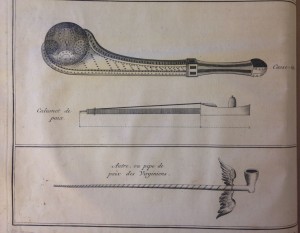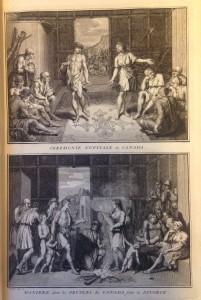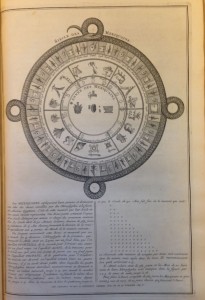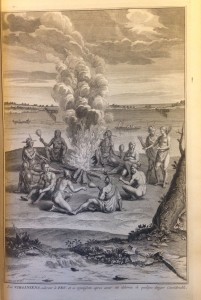The Burke Library’s special collections include hundreds of thousands of rare books, pamphlets, and manuscripts. Many of these works pertain to the Bible (its many versions and editions, their languages and interpretation), church history (especially the Reformation period and following), and theological scholarship and controversy (including incunabula, sixteenth-century English and continental pamphlets, and 19th century American tracts and sermons). The Burke’s collections also include a number of important works of natural history, philosophy, travel, and comparative religion. Included among this last group is an edition of the renowned Cérémonies et coutumes religieuses de tous les peuples du monde (Religious Ceremonies and Customs of All the Peoples of the World) by Bernard Picart and Jean Frederic Bernard.
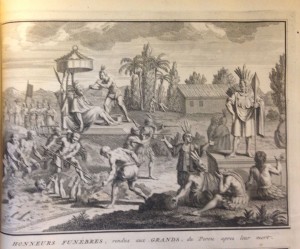 Cérémonies was pioneering in its attempt to portray the rituals and practices of the world’s religions and peoples in comparative perspective. By the standards of its day, the work was remarkably broad and even-handed in its attempt to describe religions both within and outside Europe, including Islam and religions of the “new world.” Picart engraved the hundreds of illustrations found throughout its pages and which were in large part responsible for its popularity and relative commercial success. These attempted to portray not only religious rites, but the physical structures, geographical settings, attire, equipment, and other accoutrements characteristic of the various groups included. For its contributions to a broader, more nuanced approach to world cultures, one recent work has dubbed it “The Book That Changed Europe,” while another has credited it with fostering “The First Global Vision of Religion.”
Cérémonies was pioneering in its attempt to portray the rituals and practices of the world’s religions and peoples in comparative perspective. By the standards of its day, the work was remarkably broad and even-handed in its attempt to describe religions both within and outside Europe, including Islam and religions of the “new world.” Picart engraved the hundreds of illustrations found throughout its pages and which were in large part responsible for its popularity and relative commercial success. These attempted to portray not only religious rites, but the physical structures, geographical settings, attire, equipment, and other accoutrements characteristic of the various groups included. For its contributions to a broader, more nuanced approach to world cultures, one recent work has dubbed it “The Book That Changed Europe,” while another has credited it with fostering “The First Global Vision of Religion.”
The illustrations included in volume 6 of Cérémonies are noteworthy as a moment of imperfect (e.g., the bowler-like hats and other Western garb in the images of the marriage ceremony, as well as the unfortunate ubiquity of sauvages throughout the text) but nevertheless genuine attempt to document and understand to the rich and diverse societies of the American continents’ indigenous peoples.
While at times painfully inaccurate or speculative, partly 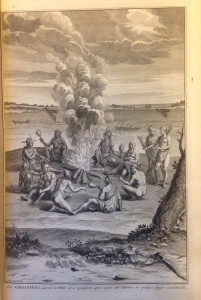 because their understanding was based largely on the reports of others, for its time the work does constitute a real attempt to understand and portray a range of cultures and religious practices, and is often characterized by a descriptive approach that would in the twentieth century develop into the study of the history of religions and inter-religious dialogue.
because their understanding was based largely on the reports of others, for its time the work does constitute a real attempt to understand and portray a range of cultures and religious practices, and is often characterized by a descriptive approach that would in the twentieth century develop into the study of the history of religions and inter-religious dialogue.
Burke’s French edition of Cérémonies (1723-1743) is comprised of 9 folio volumes that together make a striking impression as evidence of the eighteenth-century Europe’s encyclopedic labors.
In particular, Picart’s engravings remain bold and clear; despite the corrections and updates that can be made in terms of their accuracy, they are the work of a gifted and imaginative craftsman. The physical volumes can be consulted in the Burke Library’s Special Collections Reading Room, and UCLA’s library (in collaboration with the Huntington Library, the Getty Institute, and Utrecht University) has provided electronic access to the work’s several editions.
If you would like to consult the volumes at the Burke, you can request a visit here.
Please note that all images in this post are from the Burke’s copy of Volume 6 of Ceremonies et coutumes religieuses de tous les peuples du monde / représentées par des figures dessinées de la main de Bernard Picard; avec une explication historique, & quelques dissertations curieuses. Amsterdam: Chez J. F. Bernard, 1723-1743.
